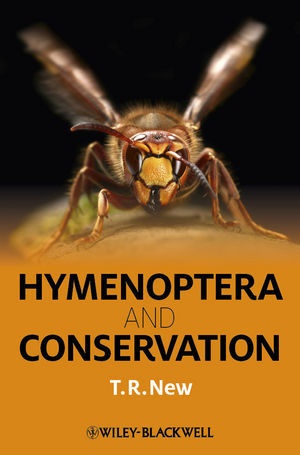Condividi
Fr. 129.00
T R New, T. R. New, T. R. (La Trobe University) New, Tim R. New, Tr New, NEW T R...
Hymenoptera and Conservation
Inglese · Copertina rigida
Spedizione di solito entro 1 a 3 settimane (non disponibile a breve termine)
Descrizione
Hymenoptera, the bees, wasps and ant, are one of the largest insect orders, and have massive ecological importance as pollinators and as predators or parasitoids of other insects. These roles have brought them forcefully to human notice , as governors of some key ecological services that strongly influence human food supply. Recent declines of pollinators and introductions of alien pests or biological control agents are only part of the current concerns for conservation of Hymenoptera, and of the interactions in which they participate in almost all terrestrial ecosystems. Both pests and beneficial species abound within the order, sometimes closely related within the same families. Many taxa are both difficult to identify, and very poorly known. This global overview, the first such account for the whole of the Hymenoptera, discusses a broad range of themes to introduce the insects and their conservation roles and needs, and how their wellbeing may be approached. The book is intended as a source of information for research workers, students, conservation managers and naturalists as an introduction to the importance of this dominant insect order.
Sommario
Preface viiAcknowledgements xii1 Introducing Hymenoptera and their Conservation 1Perspective 1Classification and diversity 1Importance for conservation 14Social life and conservation 242 Alien Hymenoptera in Classical Biological Control 28Introducing a dilemma 28Conservation concerns 283 The Junction of Biological Control and Conservation: Conservation Biological Control and Cultural Control 414 Introduced Bees: Threats or Benefits? 515 Social Wasps and Ants as Aliens 63Social wasps 63Ants 68Current perspective 796 Pollinator Declines 82Introducing the concerns 82Threats to pollinators 92Pathogens and parasites 93Pesticides 97Pollution 997 Levels of Conservation Concern and the Shortcomings of Current Practice 100Foci for conservation 100Species focus 104Biotope and habitat focus 1228 Habitat Parameters and Manipulation 138Defining and assessing habitats in the landscape 138Habitat manipulations for conservation 141Natural and agricultural environments 141Urban environments 147Practical conservation 1509 Species Case Histories 168Franklin's bumblebee (Bombus franklini) 170The great yellow bumblebee (Bombus distinguendus) 170Wallace's bee (Chalicodoma pluto) 173Neopasiphae simplicior in Western Australia 174The antennal-waving wasp (Tachysphex pechumani) 174The dinosaur ant (Nothomyrmecia macrops) 175The red-barbed ant (Formica rufi barbis) in Britain 17710 Assessing Conservation Progress and Priorities for the Future 179Introduction: The basic need 179Monitoring 180The milieux of concern 185References 191Index 214
Info autore
Emeritus Professor Tim New, from the Department of Zoology, La Trobe University, Melbourne has broad interests in insect conservation, ecology and systematics. He has published extensively on these topics and is recognised as one of the leading advocates for insect conservation.
Riassunto
Hymenoptera, the bees, wasps and ant, are one of the largest insect orders, and have massive ecological importance as pollinators and as predators or parasitoids of other insects. These roles have brought them forcefully to human notice , as governors of some key ecological services that strongly influence human food supply. Recent declines of pollinators and introductions of alien pests or biological control agents are only part of the current concerns for conservation of Hymenoptera, and of the interactions in which they participate in almost all terrestrial ecosystems. Both pests and beneficial species abound within the order, sometimes closely related within the same families. Many taxa are both difficult to identify, and very poorly known. This global overview, the first such account for the whole of the Hymenoptera, discusses a broad range of themes to introduce the insects and their conservation roles and needs, and how their wellbeing may be approached. The book is intended as a source of information for research workers, students, conservation managers and naturalists as an introduction to the importance of this dominant insect order.
Relazione
"I highly recommend Hymenoptera and Conservationto anybody who works with Hymenoptera (including invasive species, biological control and honeybees) or in general conservation, and to anyone with an interest in entomology." (Austral Ecology, 10 October 2014) "Overall, this is an interesting and worthwhile book, which should stimulate more interest in this important order of insects." (British Ecological Society, 1 April 2013) "The highly comprehensive, well-organized book presents an easy-to-understand overview of the challenges and goals associated with conservation efforts. Summing Up: Highly recommended. Students of all levels, researchers/faculty, and professionals/practitioners." (Choice, 1 April 2013) "In Hymenoptera and Conservation New captures the reader, offering a concise chronology of past interventions and, in doing so, provides lessons on which future conservation strategies can be built. For this reason, I recommend this book to anyone interested in a better understanding of the role of insects in conservation as well as the full implications of intervention." (Fauna & Flora International, 1 January 2013)
Dettagli sul prodotto
| Autori | T R New, T. R. New, T. R. (La Trobe University) New, Tim R. New, Tr New, NEW T R, New T. R. |
| Editore | Wiley, John and Sons Ltd |
| Lingue | Inglese |
| Formato | Copertina rigida |
| Pubblicazione | 03.08.2012 |
| EAN | 9780470671801 |
| ISBN | 978-0-470-67180-1 |
| Pagine | 230 |
| Categorie |
Scienze naturali, medicina, informatica, tecnica
> Biologia
> Zoologia
Life Sciences, Biowissenschaften, Naturschutzbiologie, Conservation Science |
Recensioni dei clienti
Per questo articolo non c'è ancora nessuna recensione. Scrivi la prima recensione e aiuta gli altri utenti a scegliere.
Scrivi una recensione
Top o flop? Scrivi la tua recensione.

